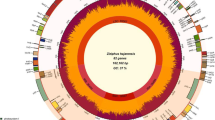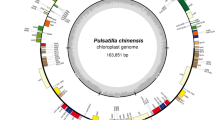Abstract
The genus Gentiana is the largest in the Gentianaceae family with ca. 400 species. However, with most species growing on the Qinghai–Tibet plateau, the processes of adaptive evolution and speciation within the genus is not clear. Also, the genomic analyses could provide important information. So far, the complete chloroplast (cp) genome data of the genus are still deficient. As the second and third sequenced members within Gentianaceae, we report the construction of complete cp sequences of Gentiana robusta King ex Hook. f. and Gentiana crassicaulis Duthie ex Burk., and describe a comparative study of three Gentiana cp genomes, including the cp genome of Gentiana straminea Maxim. published previously. These cp genomes are highly conserved in gene size, gene content, and gene order and the rps16 pseudogene with exon2 missing was found common. Three repeat types and five SSR types were investigated, and the number and distribution are similar among the three genomes. Sixteen genome divergent hotspot regions were identified across these cp genomes that could provide potential molecular markers for further phylogenetic studies in Gentiana. The IR/SC boundary organizations in Gentianales cp genomes were compared and three different types of boundaries were observed. Six data partitions of cp genomes in Gentianales were used for phylogenetic analyses and different data partitions were largely congruent with each other. The ML phylogenetic tree was constructed based on the fragments in cp genomes commonly available in 33 species from Lamiids, including 12 species in Gentianales, 1 in Boraginaceae, 10 in Solanales, and 10 in Lamiales. The result strongly supports the position of Boraginaceae (Ehretia acuminata) as the sister of Solanales, with the bootstrap values of 97 %. This study provides a platform for further research into the molecular phylogenetics of species in the order Gentianales (family Gentianaceae) notably in respect of speciation and species identification.








Similar content being viewed by others
References
Chen CH, Wang JC (1999) Revision of the genus Gentiana L. (Gentianaceae) in Taiwan. Bot Bull Acad Sin 40(1):9–38
Civaň P, Foster PG, Embley MT, Séneca A, Cox CJ (2014) Analyses of charophyte chloroplast genomes help characterize the ancestral chloroplast genome of land plants. Genome Biol Evol 6(4):897–911
Conant GC, Wolfe KH (2008) GenomeVx: simple web-based creation of editable circular chromosome maps. Bioinformatics 24(6):861–862
Edgar RC (2004) MUSCLE: multiple sequence alignment with high accuracy and high throughput. Nucleic Acids Res 32(5):1792–1797
Frazer KA, Pachter L, Poliakov A, Rubin EM, Dubchak I (2004) VISTA: computational tools for comparative genomics. Nucleic Acids Res 32(suppl 2):W273–W279
George B, Bhatt BS, Awasthi M, George B, Singh Achuit K (2015) Comparative analysis of microsatellites in chloroplast genomes of lower and higher plants. Curr Genet 61(4):665–677
Gielly L, Yuan YM, Kupfer P, Taberlet P (1996) Phylogenetic use of noncoding regions in the genus Gentiana L.: chloroplast trnL (UAA) intron versus nuclear ribosomal internal transcribed spacer sequences. Mol Phylogenet Evol 5(3):460–466
Gogniashvili M, Naskidashvili P, Bedoshvili D, Kotorashvili A, Kotaria N, Beridze T (2015) Complete chloroplast DNA sequences of Zanduri wheat (Triticum spp.). Genet Resour Crop Evol 62:1269–1277
Guo W, Grewe F, Cobo-Clark A, Fan W, Duan Z, Adams RP, Schwarzbach AE, Mower JP (2014) Predominant and substoichiometric isomers of the plastid genome coexist within Juniperus plants and have shifted multiple times during cupressophyte evolution. Genome Biol Evol 6(3):580–590
He TN (1988) Genus Gentiana. In: He TN (ed) Flora reipublicae Popularis Sinicae, vol 62., GentianaceaeScience Press, Beijing, pp 14–257
Ho TN, Liu SW (1990) The infrageneric classification of Gentiana (Gentianaceae). Bull Br Mus Nat Hist Bot Ser 20:169–192
Ho TN, Liu SW (2002) A worldwide monograph of Gentiana. Science press, Beijing, p i
Huang H, Shi C, Liu Y, Mao SY, Gao LZ (2014) Thirteen Camellia chloroplast genome sequences determined by high-throughput sequencing: genome structure and phylogenetic relationships. BMC Evol Biol 14(26):4302–4315
Kuang DY, Wu H, Wang YL, Gao LM, Zhang SZ, Lu L (2011) Complete chloroplast genome sequence of Magnolia kwangsiensis (Magnoliaceae): implication for DNA barcoding and population genetics. Genome 54(8):663–673
Kurtz S, Schleiermacher C (1999) REPuter: fast computation of maximal repeats in complete genomes. Bioinformatics 15(5):426–427
Li XJ, Wang LY, Yang HL, Liu JQ (2007) Confirmation of natural hybrids between Gentiana straminea and G. siphonantha (Gentianaceae) based on molecular evidence. Acta Bot Yunnanica 29(1):91–97
Li XW, Hu ZG, Lin XH, Li Q, Gao HH, Luo GA, Chen SL (2012) High-throughput pyrosequencing of the complete chloroplast genome of Magnolia officinalis and its application in species identification. Acta Pharm Sin 47(1):124–130
Ma J, Li XQ (2015) Organellar genome copy number variation and integrity during moderate maturation of roots and leaves of maize seedlings. Curr Genet 61(4):591–600
Ma YC, Hsia KC, Hsiao PK (1964) Study on the genus Gentiana L. section Aptera Kusnez. in China. Acta Sci Nat Univ Neimongol 6(1):33–51
Moore MJ, Bell CD, Soltis PS, Soltis DE (2007) Using plastid genome-scale data to resolve enigmatic relationships among basal angiosperms. Proc Natl Acad Sci USA 104(49):19363–19368
Ni LH, Zhao ZL, Xu HX, Chen SL, Gaawe D (2016) The complete chloroplast genome of Gentiana straminea (Gentianaceae), an endemic species to the Sino-Himalayan subregion. Gene 577(2):281–288
Oldenburg DJ, Bendich AJ (2015) The linear plastid chromosomes of maize: terminal sequences, structures, and implications for DNA replication. Curr Genet. doi:10.1007/s00294-015-0548-0
Palmer JD (1991) Plastid chromosomes: structure and evolution. In: Vasil IK, Bogorad L (eds) Cell culture and somatic cell genetics in plants, the molecular biology of plastids, vol 7A. Academic Press, San Diego, pp 5–53
Raubeson LA, Jansen RK (2005) Chloroplast genomes of plants. In: Henry R (ed) Diversity and evolution of plants-genotypic variation in higher plants. CABI Publishing, Oxfordshire, pp 45–68
Ruhfel BR, Gitzendanner MA, Soltis PS, Soltis DE, Burleigh JG (2014) From algae to angiosperms-inferring the phylogeny of green plants (Viridiplantae) from 360 plastid genomes. BMC Evol Biol 14(1):385–399
Schattner P, Brooks AN, Lowe TM (2005) The tRNAscan-SE, snoscan and snoGPS web servers for the detection of tRNAs and snoRNAs. Nucleic Acids Res 33(suppl 2):W686–W689
Tamura K, Peterson D, Peterson N, Stecher G, Nei M, Kumar S (2011) MEGA5: molecular evolutionary genetics analysis using maximum likelihood, evolutionary distance, and maximum parsimony methods. Mol Biol Evol 28(10):2731–2739
The Angiosperm phylogeny group (2009) An update of the Angiosperm Phylogeny Group classification for the orders and families of flowering plants: APG III. Bot J Linn Soc 161(2):105–121
Thiel T, Michalek W, Varshney RK, Graner A (2003) Exploiting EST databases for the development and characterization of gene-derived SSR-markers in barley (Hordeum vulgare L.). Theor Appl Genet 106(3):411–422
Vieira LD, Dos Anjos KG, Faoro H, Fraga HP, Greco TM, Pedrosa FO, de Souza EM, Rogalski M, de Souza RF, Guerra MP (2015) Phylogenetic inference and SSR characterization of tropical woody bamboos tribe Bambuseae (Poaceae: Bambusoideae) based on complete plastid genome sequences. Curr Genet. doi:10.1007/s00294-015-0549-z
Wyman SK, Jansen RK, Boore JL (2004) Automatic annotation of organellar genomes with DOGMA. Bioinformatics 20(17):3252–3255
Yang JB, Yang SX, Li HT, Yang J, Li DZ (2013) Comparative chloroplast genomes of Camellia species. PLoS One 8(8):e73053
Yap JY, Rohner T, Greenfield A, Van Der Merwe M, McPherson H, Glenn W, Kornfeld G, Marendy E, Pan AY, Wilton A, Wilkins MR, Rossetto M, Delaney SK (2015) Complete chloroplast genome of the Wollemi pine (Wollemia nobilis): structure and evolution. PLoS ONE 10(6):e0128126
Young HA, Lanzatella CL, Sarath G, Tobias CM (2011) Chloroplast genome variation in upland and lowland switchgrass. PLoS One 6(8):e23980
Yuan YM, Küpfer P (1997) The monophyly and rapid evolution of Gentiana sect. Chondrophyllae Bunge s.l. (Gentianaceae): evidence from the nucleotide sequences of the internal transcribed spacers of nuclear ribosomal DNA. Bot J Linn Soc 123(1):25–43
Yuan YM, Küpfer P, Doyle JJ (1996) Infrageneric phylogeny of the genus Gentiana (Gentianaceae) inferred from nucleotide sequences of the internal transcribed spaces (ITS) of nuclear ribosomal DNA. Am J Bot 83(5):641–652
Zhang XL, Ge XJ, Liu JQ, Yuan YM (2006) Morphological, karyological and molecular delimitation of two gentians: Gentiana crassicaulis versus G. tibetica (Gentianaceae). Acta Phytotaxon Sin 44(6):627–640
Zhang XL, Yuan YM, Ge XJ (2007) Genetic structure and differentiation of Gentiana atuntsiensis W. W. Smith and G. striolata T. N. Ho (Gentianaceae) as revealed by ISSR markers. Bot J Linn Soc 154(2):225–232
Zhang XL, Wang YJ, Ge XJ, Yuan YM, Yang HL, Liu JQ (2009) Molecular phylogeny and biogeography of Gentiana sect. Cruciata (Gentianaceae) based on four chloroplast DNA datasets. Taxon 58(3):862–870
Zhang Y, Li L, Yan TL, Liu Q (2014) Complete chloroplast genome sequences of Praxelis (Eupatorium catarium Veldkamp), an important invasive species. Gene 549(1):58–69
Zhao ZL, Dorje G, Wang ZT (2010) Identification of medicinal plants used as Tibetan traditional medicine Jie-Ji. J Ethnopharmacol 132(1):122–126
Acknowledgments
The authors thank MSc Christine Leon from Royal Botanic Gardens, Kew for assistance in English revision. Also, this work was supported by grants from the National Natural Science Foundation of China (No. 81173654).
Author information
Authors and Affiliations
Corresponding author
Ethics declarations
Conflict of interest
There is no conflict of interest.
Additional information
Communicated by M. Kupiec.
Electronic supplementary material
Below is the link to the electronic supplementary material.
Rights and permissions
About this article
Cite this article
Ni, L., Zhao, Z., Xu, H. et al. Chloroplast genome structures in Gentiana (Gentianaceae), based on three medicinal alpine plants used in Tibetan herbal medicine. Curr Genet 63, 241–252 (2017). https://doi.org/10.1007/s00294-016-0631-1
Received:
Revised:
Accepted:
Published:
Issue Date:
DOI: https://doi.org/10.1007/s00294-016-0631-1




